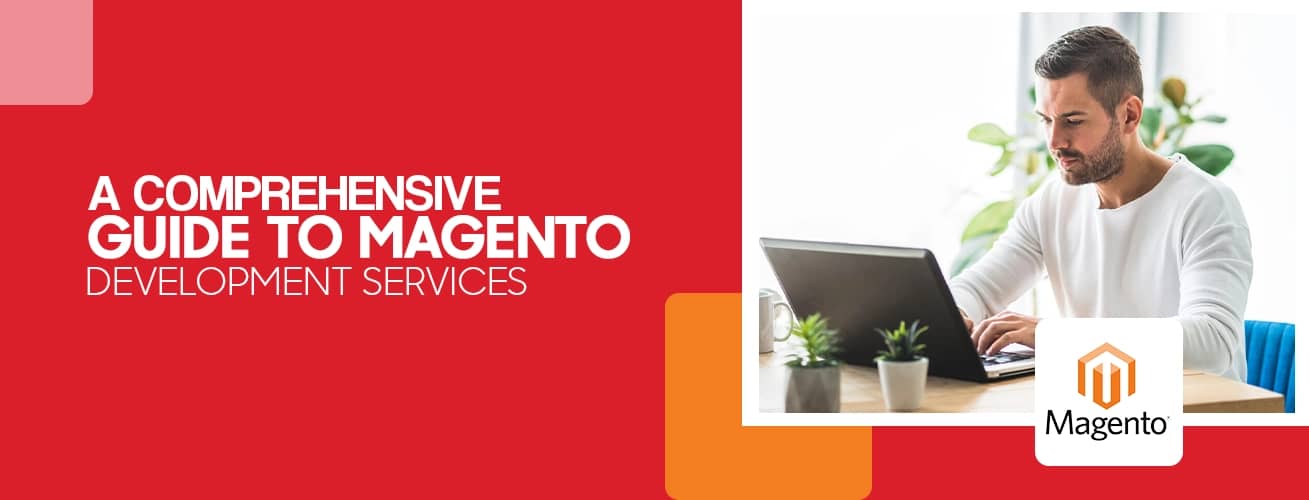A Comprehensive Guide to Magento Development Services
Do you know Nike, Burger King, and many famous brands are using Magento for their online stores? Magento has become the platform of choice for many businesses in the market. It is a prominent eCommerce platform, enabling Magento developers to come up with feature-packed and performance-optimized online stores. The fact that more than 270,000 merchants are using Magento and this eCommerce giant handles more than $100 billion in gross merchandise annually shows how popular it is.
But it should be noted there are other eCommerce platforms as well such as Shopify, WooCommerce, BigCommerce, OpenCart, and more. This abundance of available solutions creates confusion about businesses. Quite naturally, they often ask when there are multiple eCommerce development platforms out there, why they should invest in Magento development services. What benefits they can accrue by hiring the services of Magento developers?
These are some of the many questions that deserve our closer examinations. In this blog, we will be exploring everything you need to know to have Magento-based feature-rich eCommerce solutions.
We first start with a brief overview of Magento development services.
What Are Magento Development Services:
Magento Development services are primarily concerned with designing and implementing eCommerce stores using the Magento open-source platform. These services are of two types:
- Development of new online stores from scratch.
- Customization of existing online by adding new capabilities and functionalities
In addition, Magento developers perform other associated tasks as well such as online store maintenance and upgradation, integration of Third-Party apps, website testing, migration to the latest version, and the like.
Why Should You Select Magento Platform for eCommerce Stores:
In this age of competitive eCommerce market, why you should go for Magento, the answer is pretty simple: the number of features that this platform offers.
Here are some compelling reasons why you should invest in Magento Dev services for your online stores.
#1: Themes and Extensions:
Themes and extensions are now become integrated parts of every online store. They play a role in enhancing the functionalities and features of websites and eCommerce stores. Magento is preferred because it has a marketplace for a large number of themes and extensions.
It has as many as 3200 themes, you can choose them as per your requirements and needs. This will help your store to offer a user-friendly shopping experience or better market products, and so on.
#2: Dynamic and Vast Magento Community:
A large and expanding eCommerce community is a great asset. It can help Magento developers and store managers resolve everyday problems quite efficiently.
Magento has a unique distinction of boasting a large community. There are more than 470,000 Magento forums available for resolving your issues without spending any budget.
#3: Open-Source Platform:
One of the most important reasons for using Magento Online Store and Web Development services is that it is open-source and freely available.
Businesses can use this platform to build and run feature-rich online stores cost-efficiently. Moreover, it offers flexibility and customization, enabling web and store managers to adjust Magento solutions as per their needs and specific business requirements.
#4: SEO and Marketing Features:
Needless to say, SEO and marketing tools are key to running a successful eCommerce. Magento is a most-after eCommerce platform precisely for this reason. It comes with enabled SEO and marketing features that help in running SEO campaigns effectively.
Magento supports advanced analytics and reporting, promotion, URL structures, metadata, descriptions, tags, and sitemaps. Magento developers exploit these features and come up with SEO-friendly websites and stores.
#5: Robust Security Features:
Since eCommerce stores have to perform many financial transactions, therefore, security for users’ information, credit, and payment details naturally become the topmost priority.
Luckily, Magento supports advanced and robust security features. It features secure payment gateways, data encryption, PCI compliance, SSL security, and more. These features make sure that all critical and sensitive data remain protected from malicious cyberattacks including ransomware, and malware.
#06: Advanced Tech Stacks:
Magento, Magento 2 in particular, is pre-equipped with advanced tech stacks that ensure website customization and performance optimization.
Here are some prominent security architectures supported by the Magento platform.
- Symphony
- Composer
- Varnish
- NGINX
#07: Smooth Integration:
Integration to other eCommerce platforms and Third-Party applications is important for performance optimization. Magento should be given priority here.
Magento features extensive APIs, flexible architecture, and modular systems. These built-in capabilities ensure a cross-platform integration for improved performance and data security.
Having discussed some reasons that drive the popularity of the Magento platform, now, we will dwell upon some of the latest trends in Magento eCommerce Development.
Top Magento eCommerce Trends 2024:
Here are some key trends that are transforming Magento eCommerce development services profoundly.
#01: Progressive Web Applications (PWAs):
Progressive Web Applications are hybrid, combining the best features of web and mobile applications. They are trending because they are fast, reliable, secure, and can be installed like native apps. They offer many advantages over traditional web and mobile applications, for instance:
- Improved User Experience
- Enhanced loading times
- Increased customer engagement
- Boosted performance
Magento PWA Studio is a tool that is used for developing PWA. These Magento tools enable developers to come up with Magento PWAs that are feature-packed and performance-optimized.
#02: AI and Machine Learning:
Recently, Artificial Intelligence and Machine Learning have become a priority for Magento web developers and merchants. Both AI and ML are used for many tasks such as task automation, personalized shopping experience, and more.
Magento offers support to these advanced features via Magento AI and ML Toolkit. These tools enable developers to incorporate multiple AI features into solutions. For instance:
- Detection of fraud
- Chatbots
- Personalized Product Recommendations
- Security
- Personalized Search Results
#03: Virtual Reality (VR) and Augmented Reality (AR):
VR and AR are now technologies that are transforming the visual, advertising, and shopping experience. Now when Metaverse is right on the corner, VR and AR seem critical for staying relevant in the online and digital world.
Magento supports VR and AR through integration with Third-Party Apps. Businesses can incorporate these AR- and VR-enabled features that can improve their revenue. For instance, AR and VR experiences can allow users to try on clothes, use furniture, view products in 3D, and more.
#04: Omni-Channel Integration:
Omni-Channel Integration is an integrated interactive ecosystem that allows users to communicate with businesses through all possible channels such as offline, online, mobile, etc. Needless to say, this integration of multiple channels goes a long way in improving customer experience and boosting revenue.
Magento has a built-in Order Management System and integration with CRM systems POS systems and the like Third-Party applications. This helps Magento store managers enable omnichannel integration to offer a better user experience.
#05: Voice Commerce:
Voice commerce is growing eCommerce trends. It helps businesses utilize voice assistants such as Amazon Alexa and Google Assistant to sell their products online. Voice commerce facilitates shopping and is handy for visually impaired people.
Magento provides seamless integration with Amazon Alexa. This integration allows businesses to better exploit Voice Commerce and boost their revenue online.
A Step-by-Step Guide to Build Magento Solution:
Here is a list of tasks that are performed for building Magento stores and Magento websites.
- Knowing Magento Stack Requirements
- Selecting Web Hosting and Domain Name
- Downloading and Installing Magento
- Configuring Store Settings
- Choosing an Appropriate Theme for Store
- Installing Extensions in line with Requirements
- Setting Up/Importing Product Pages
- Previewing and Publishing Store
#01: Determination of Stack Requirements:
Like any other eCommerce platform, the proper functioning of Magento demands specific server and stack requirements. Here are some requirements for Magento 1 and Magento 2.
Web Server:
Magento 1 would require Apache 1.3x, Nginx 1.7x and advanced versions
Magento 2 demands Apache 2.0 and Nginx 1.18
Operating System:
Linux x86-64 for Magento 1.
Linux-based OS such as CentOS, Ubuntu, and RHEL for Magento 2.
Required Memory:
Minimum 512 MB or more RAM for Magento 1 and at least 2 GB or more RAM for Magento 2.
PHP:
PHP 7.2 and PHP 8.0 and above for Magento 1 and PHP 5.4 for Magento 2
Security:
Valid SSL certificate
TLS for PayPal integration and repo.magento.com
#02: Selection of Web Hosting and Domain Name:
Selecting an appropriate web hosting and domain name is crucially required for making an online store or website live. Here are some key points:
- First, always choose a hosting provider that offers the requisite Magento stack requirements.
- Secondly, pick a web hosting provider that is fast, secure, and reliable for offering reliable protection against cyber-attacks.
- Thirdly, don’t go for a cheaper one. It would compromise your security.
For beginners, this is a list of top web hosting providers in the market.
- GoDaddy
- Siteground
- Cloudways
- A2hosting
- Host Duplex
#03: Downloading and Installing Magento:
After selecting a web hosting provider and purchasing a domain name, it is time now for downloading and installing.
- First, make an account on Adobe’s website and start downloading/installing Magento.
- Second, choose the latest version, there are Magento 1, Magento 2, Open Source, and Adobe Commerce. Select that is the latest and best serves your needs.
- Third, install them by adjusting the configuring settings.
#04: Configuration of Store Settings:
The fourth step in Magento development is the configuration of store settings. After installation, open Magento Dashboard, and search Store≥Configuration≥General.
Adjust settings such as Country, State, Store, time zone, Phone Number, and the like.
#05: Choosing and Installing Theme for Store:
Now, it is time to adjust the look and feel of your store as per your branding needs. You can do that by selecting a theme. You can perform this task by two means:
Magento 2 has built-in Luma and Blank. If you don’t want to invest more, you can simply customize these built-in themes to your specific needs.
The second option is visiting Magento Marketplace and buying the theme of your choosing. This will obviously cost you some bucks but do spend that because it is a very important step in Magento eCommerce development.
#06: Installation of Extensions for Advanced Functionalities:
Extensions are important to extend the functionalities and capabilities of your online store. You first need to define your requirements and then choose a particular extension as per your needs. Magento eCommerce developers offer a large number of extensions. You can buy them to meet your following needs.
- Analytics Tracking
- Marketing
- Security
- Payment Gateways
- Shipping
#07: Setting Up/Importing Product Pages:
After installing extensions, now it is time to set up product pages. You can import products as well. The following options are available:
- Bundle Products
- Simple Products
- Group Products
- Configurable Products
- Virtual Products
- Downloadable products
You can import products by navigating the System≥Import of Magento Dashboard.
#08: Payment Gateway and Shipping Options:
This is an important step in the Magento eCommerce development process. Let’s see how it is done.
First, we start with selecting a payment gateway in Magento. Go to Magento Dashboard and then Stores > Configuration > Sales. There you will some popular methods such as
- Cash on Delivery
- Bank Transfer Payment
- Money Order/Cheque
- Zero Subtotal Checkout
Besides these traditional methods, you can also choose some popular payment gateways such as PayPal, Authorize.net, and the like.
The second is a selection of Shipping methods. Similar to payment, visit the Magento Dashboard and navigate through to Stores > Configuration > Sales. Here you will see shipping methods such as Free Shipping, Flat Rate, Table Rate, etc. You can choose one of them.
#09: Previewing and Publication of Online Store:
It is the final step now. You can now push your store live and start generating revenue. But you must first review your websites. You can test various aspects such as speed, checkout process, page responsiveness, and other criteria.
If everything is in order, make your store live.
There You Go!
Final Thoughts:
Magento has become one of the most popular eCommerce platforms. It is powering hundreds of thousands of websites and stores now. It is popular because it is open source, it allows easy customization, it has built-in SEO and marketing capabilities, and more. In line with the fast-evolving digital space, new trends such as AR/VR, AI, Machine Learning, and other tendencies are taking root, making Magento a well-adapted eCommerce platform. You can use the above-said 9 steps for launching a Magento store and start generating revenue instantly.
We do hope that this blog will help you better understand Magento and you will feel confident about using this platform for eCommerce business.




